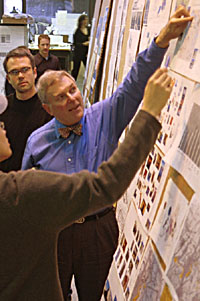
Alexander Garvin |
to rebuild Twin Tower site
Yale got a further foothold into the rebuilding process of the World Trade Center (WTC) with the appointment of School of Architecture alumnus and faculty member Alexander Garvin to oversee the redevelopment of lower Manhattan.
The School of Architecture has already become associated with the site by virtue of the projects assigned to its students by visiting professors Frank Gehry and Zaha Hadid, who are both teaching master studio classes this term.
Gehry, a world-renowned designer, has charged students in his class to design a one-room monument for the WTC site. Hadid, an internationally acclaimed London-based designer and theorist, has asked her class to consider a new kind of office complex to replace the Twin Towers.
Garvin is used to shuttling between Manhattan, where he has served on the City Planning Commission for many years, and New Haven, where he is an adjunct professor at the School of Architecture, teaching urban planning and development at the undergraduate and graduate levels.
His course "Study of the City," which uses such techniques as role-playing and field visits to Manhattan, is a popular mainstay of the Yale College curriculum.
"Alex Garvin has had a profound effect on New York City," said Robert A.M. Stern, dean of the Yale School of Architecture. "I can think of no one who knows more about New York and how it works."
Although the exact site of the Twin Towers is the most important part of the project, Garvin says, he will be overseeing the redevelopment and revitalization of all of lower Manhattan -- everything from rewiring buildings to changing the street system and subway lines. Garvin will bring together agencies, organizations, commissions and developers, along with residents, property owners and area retailers.
Garvin will work in concert with two other graduates of the School of Architecture -- Andrew Winters '94 M.Arch. and Christopher Glaisek '96 M.Arch. -- and he expects to take a serious look at the proposals of Gehry's and Hadid's students. "I'll take everybody's interests into consideration," he says.
Reflecting on the spiritual dimension of his project, especially for those who suffered losses, Garvin pauses, "There's no way we can grasp the meaning for those affected."
Garvin holds Bachelor of Arts (1964), Master of Urban Studies (1967) and Master of Architecture (1967) degrees from Yale. His extracurricular accomplishments range from private practice to public service. From 1970 to 1980, he served in city government as deputy commissioner of housing and director of comprehensive planning. He is a fellow of the Urban Land Institute and a member of the National Advisory Council to the Trust for Public Land.
In the private sector, Garvin runs his own consultancy practice for urban planning and real estate development. He is a prolific writer and lectures widely. He is the author or principal author of several books, including "The American City: What Works, What Doesn't," which won the 1996 American Institute of Architects book award in urbanism; "Urban Parks and Open Space"; and the recently released "Parks, Recreation, and Open Space: A 21st Century Agenda."
In addition to his position on the City Planning Commission, Garvin has been active in the campaign to lure the Summer Olympics games to New York in his role as the planning director of the NYC2012 committee.
Despite his proven mastery of urban planning, Garvin admits that his new position as vice president for planning, design and development of the Lower Manhattan Development Corporation presents daunting challenges.
"I have been planning most of my adult life," he says. "But this is a unique project, unlike anything I have ever done before."
T H I S
Bulletin Home
 W E E K ' S
W E E K ' S S T O R I E S
S T O R I E S![]()
 Yale architect leading effort to rebuild Twin Tower site
Yale architect leading effort to rebuild Twin Tower site
![]()
![]()
 Cellist will tour nation as winner of Sphinx Prize
Cellist will tour nation as winner of Sphinx Prize![]()
![]()
 University awards sailing varsity status
University awards sailing varsity status
![]()
![]()
 Town-gown project aims to bring health information to underserved
Town-gown project aims to bring health information to underserved![]()
![]()
 Nurse warns against repeating Tuskegee abuses
Nurse warns against repeating Tuskegee abuses![]()
![]()
 Unique program will assess democracy at work
Unique program will assess democracy at work![]()
![]()
 Doing good is good for you, Yale chaplain tells students
Doing good is good for you, Yale chaplain tells students![]()
![]()
 Speakers to explore interrelationship of 'Law and Truth'
Speakers to explore interrelationship of 'Law and Truth'![]()
![]()
 Exhibition explores ever-expanding art of collage
Exhibition explores ever-expanding art of collage![]()
![]()
 Fourth annual Klezmerpalooza festival returns home to Yale
Fourth annual Klezmerpalooza festival returns home to Yale![]()
![]()
 Policy Statement: Adding Varsity Opportunities
Policy Statement: Adding Varsity Opportunities![]()
![]()
 Yale Books in Brief
Yale Books in Brief![]()
![]()
 Campus Notes
Campus Notes![]()
 |
| Visiting on Campus
Visiting on Campus |
| Calendar of Events
Calendar of Events |
| In the News
In the News |
| Bulletin Board
Bulletin Board![]()
Yale Scoreboard |
| Classified Ads
Classified Ads |
| Search Archives
Search Archives |
| Deadlines
Deadlines![]()
Bulletin Staff |
| Public Affairs Home
Public Affairs Home |
| News Releases
News Releases |
| E-Mail Us
E-Mail Us |
| Yale Home Page
Yale Home Page